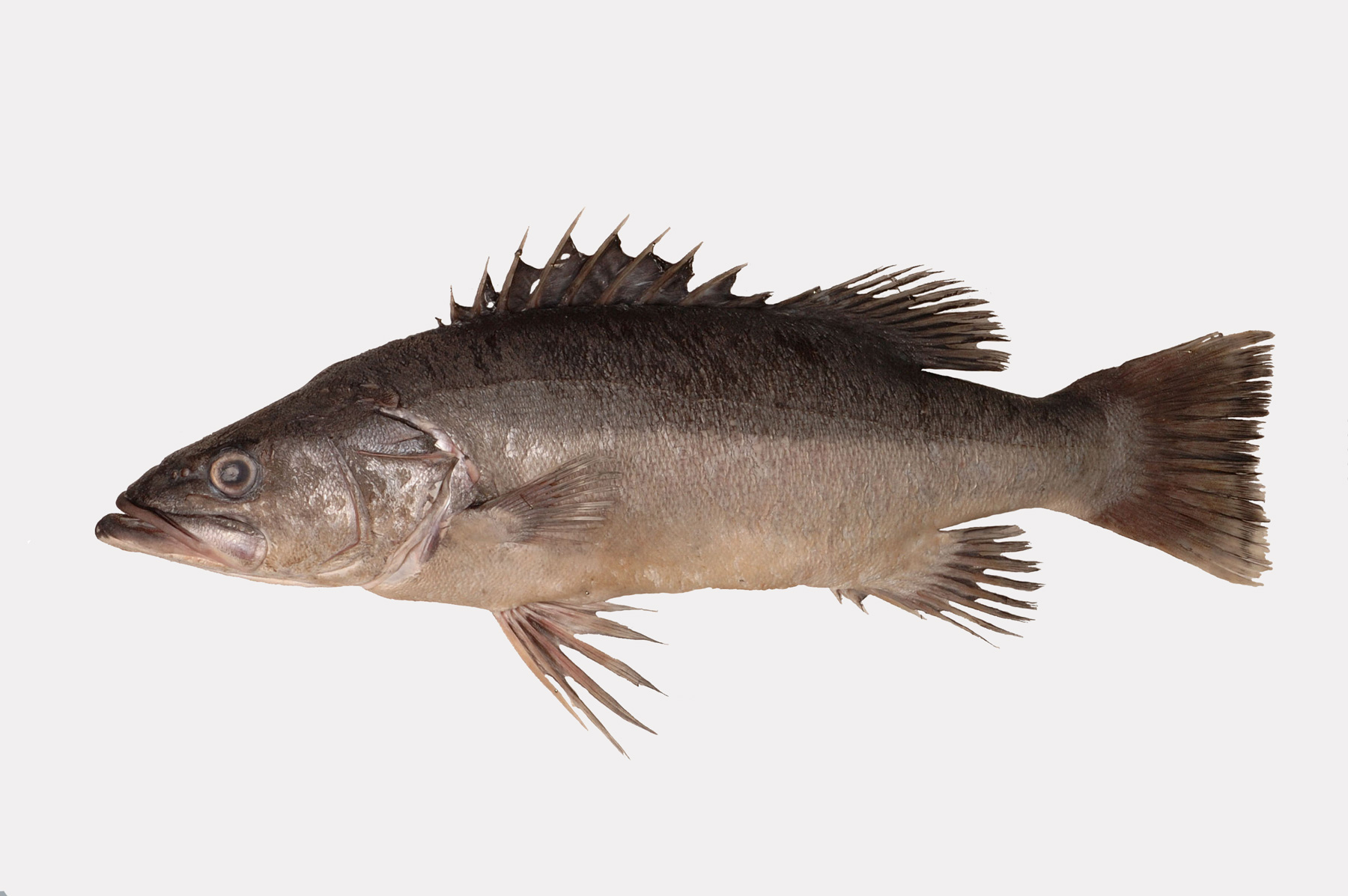Hapuku, Polyprion oxygeneios (Forster 1801)

A Hapuku, Polyprion oxygeneios, taken on a longline off the east coast of Tasmania, Australia. Source: Martin Gomon / Museum Victoria. License: CC BY Attribution
A large, long-lived perch-like fish that may grow to a length of 1.8 metres, and live to more than 60 years. In Australia, Hapuku are taken as bycatch in deep-sea dropline fisheries targetting Blue-eye Trevalla.
Hapuku, Polyprion oxygeneios (Forster 1801)
More Info
|
Distribution |
Widespread in temperate waters of the Southern Hemisphere. Known from temperate waters of southern Australia from the Sydney region (New South Wales) to Rottnest Island (Western Australia), and around Tasmania. Adults usually live around deep reffs and canyons on the mid-continental shelf to upper slope in depths of 50-640 metres. Juveniles usually inhabit surface waters, often swimming amongst drfiting seaweed. |
|
Features |
Dorsal fin IX-XII, 11-12; Anal fin III, 9-11; Caudal fin 17; Pectoral fin 17-19; Pelvic fin I, 5; Vertebrae 13 + 14; Lateral line scales (onto caudal fin) 77-98. Body oblong, of moderate depth (25-30% SL), slightly compressed. Head large (33-40% SL) with pointed snout; eyes small (15-17% HL); mouth large, oblique, lower jaw protruding; teeth villiform in broad bands in both jaws, present on vomer, palatines and tongue; opercula angular with prominent horizontal ridge ending in strong spine; preopercles rounded with small but strong serrations. Scales ctenoid, covering body, head and fin bases, 140-180 in longitudinal series. Single dorsal fin with a long-based spinous section possessing low notch just before soft part; anal fin with three small spines, third longest; caudal-fin truncate or slightly emarginate. Pectoral and pelvic fins rather small. |
|
Size |
A large fish reaching a standard length of about 1.5 metres, and a total length of 1.8 metres. The maximum reported weight is 100 kg, although some report 70 kg. |
|
Colour |
Steely-grey, much darker above and on the outer margins of the fins. |
|
Feeding |
Carnivore - feeds on a variety of benthopelagic and bottom-dwelling fishes and invertebrates. |
|
Biology |
Little is known of the biology of Hapuku in Australian waters. The sexes are separate and fertilisation is external. Hapuku mature at 10-13 years and may live to more than 60 years. They spawn in midwinter following a pre-spawning migration. The eggs and larvae are pelagic. Anderson et al. (2012) described eggs and larvae reared in laboratory conditions. Hapuku have an extended pelagic juvenile phase, and spend up to 4 years in the open ocean before settling out in deeper water. Although Hapuku are widespread in sou9thern hemisphere waters, genetic studies have shown that there three distinct populations |
|
Fisheries |
A highly valued commercial and recreational fish, taken in small numbers in Australia, mostly as bycatch in the deepsea Blue-eye Trevalla fishery. Hapuku are commercially important in New Zealand waters where they are taken in large numbers by long-line fishers. There is some concern that populations can be easily overfished. The flesh is excellent eating. |
|
Similar Species |
Differs from the Bass Groper, Polyprion americanus, in having a shallower body (less than 30% standard length), and a distinctly counter-shaded colour pattern - adults are dark above and paler below; pelagic juveniles have oblique bands on the body. |
|
Species Citation |
|
|
Author |
Bray, D.J. 2018 |
|
Resources |
Hapuku, Polyprion oxygeneios (Forster 1801)
References
Anderson, S.A., Salinas, I., Walker, S.P., Gublin, Y., Pether, S., Kohn, Y.Y. & Symond, J.E. 2012. Early development of New Zealand hapuku Polyprion oxygeneios eggs and larvae. Journal of Fish Biology 80(3): 555–571.
Beentjes, M.P. & Francis, M.P. 1999. Movement of hapuku (Polyprion oxygeneios) determined from tagging studies. New Zealand Journal of Marine and Freshwater Research 33: 1–12.
Francis, M.P., K.P. Mulligan, N.M. Davies & M.P. Beenties. 1999. Age and growth estimates for New Zealand hapuku, Polyprion oxygeneios. Fish. Bull. 97(2): 227-242.
Grant, E. 1987. Fishes of Australia. E. M. Grant PTY Limited, Queensland, Australia.
Hutchins, J.B. & Thompson, M. 1983. The Marine and Estuarine Fishes of South-western Australia. Perth : Western Australian Museum 103 pp. 345 figs
Kuiter, R.H. 1993. Coastal Fishes of South-eastern Australia. Bathurst : Crawford House Press 437 pp.
Last, P.R., Scott, E.O.G. & Talbot, F.H. 1983. Fishes of Tasmania. Hobart : Tasmanian Fisheries Development Authority 563 pp. figs
May, J.L. & Maxwell, J.G.H. 1986. Field Guide to Trawl Fish from Temperate Waters of Australia. Hobart : CSIRO Division of Marine Research 492 pp.
Roberts, C.D. 1989. Reproductive mode in the percomorph fish Polyprion Oken. Journal of Fish Biology 34(1): 1-10.
Roberts, C.D. 1996. Hapuku and bass: the mystery of the missing juveniles. Seafood New Zealand 4: 17-21.
Roberts, C.D. & Gomon, M.F. 2008. Families Polyprionidae, Serranidae and Callanthiidae. pp. 534-549 in Gomon, M.F., Bray, D.J. & Kuiter, R.H. (eds). Fishes of Australia's Southern Coast. Sydney : Reed New Holland 928 pp.
Wakefield, C.B., Newman, S.J. & Molony, B.W. 2010. Age-based demography and reproduction of hapuku, Polyprion oxygeneios, from the south coast of Western Australia: implications for management. ICES Journal of Marine Science 67: 1164–1174.
Yearsley, G.K., Last, P.R. & Ward, R.D. (eds) 1999. Australian Seafood Handbook. Hobart : CSIRO Marine Research 460 pp.

